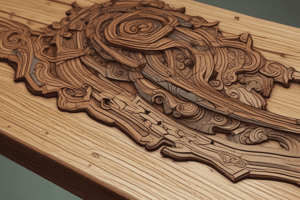Podcast
Questions and Answers
What is the primary purpose of sealing wood surfaces?
What is the primary purpose of sealing wood surfaces?
- To provide color and design
- To create a high-gloss finish
- To enhance the natural color of the wood
- To protect surfaces from moisture and damage (correct)
Which finishing technique is best suited for achieving a hard, protective layer over wood?
Which finishing technique is best suited for achieving a hard, protective layer over wood?
- Waxing
- Oiling
- Lacquering (correct)
- Staining
What is the main characteristic of French polishing?
What is the main characteristic of French polishing?
- It creates a high-gloss finish using shellac. (correct)
- It is primarily used for outdoor applications.
- It is a quick method of applying a glossy finish.
- It uses oil to penetrate and enhance wood's natural beauty.
Which technique is recommended to add character and an antique look to finished pieces?
Which technique is recommended to add character and an antique look to finished pieces?
What is the role of primer in the painting process?
What is the role of primer in the painting process?
Flashcards are hidden until you start studying
Study Notes
Finishing Techniques
-
Sanding
- Smoothens surface for paint or varnish adherence.
- Different grits (e.g., coarse, medium, fine) used for various stages.
-
Staining
- Enhances wood grain by adding color.
- Can be oil-based or water-based.
- Requires careful application to avoid blotches.
-
Sealing
- Protects surfaces from moisture and damage.
- Types include polyurethane, lacquer, and shellac.
- Often applied after staining to lock in color.
-
Painting
- Provides color and protection.
- Types include oil-based, water-based, spray, or brush-on.
- Requires primer for better adhesion on some surfaces.
-
Varnishing
- Creates a hard, protective layer over wood.
- Available in different finishes: gloss, satin, and matte.
- Enhances durability and appearance.
-
Oiling
- Penetrates wood to enhance natural beauty.
- Includes options like tung oil and Danish oil.
- Provides a natural finish that is easy to maintain.
-
French Polishing
- Traditional method using shellac and a rubbing pad.
- Creates a high-gloss finish.
- Requires skill and patience; time-consuming.
-
Waxing
- Adds a soft sheen and provides a protective barrier.
- Easy to apply and maintain.
- Best for pieces not subjected to heavy wear.
-
Burnishing
- Rubbing the surface to create a smooth, shiny finish.
- Often used in leatherworking and woodworking.
- Enhances appearance without additional products.
-
Lacquering
- Quick-drying finish that forms a hard coat.
- Available in various sheens.
- Requires proper ventilation during application due to fumes.
-
Clear Coats
- Transparent finishes that protect without altering color.
- Ideal for enhancing the natural look of wood.
- Often used over stains or bare wood.
-
Distressing
- Technique to create a weathered or antique look.
- Methods include sanding, scraping, or using specialized tools.
- Adds character and uniqueness to finished pieces.
Finishing Techniques Overview
- Finishing techniques enhance the appearance and durability of surfaces, particularly wood.
Sanding
- Smooths surfaces, aiding in paint or varnish adhesion.
- Utilizes various grits: coarse for shaping, medium for refining, fine for finishing.
Staining
- Enhances the natural grain of wood with color.
- Available in oil-based or water-based formulas.
- Requires careful application to prevent blotchy results.
Sealing
- Protects surfaces from moisture and damage, prolonging lifespan.
- Common types include polyurethane, lacquer, and shellac.
- Typically applied post-staining to lock in color.
Painting
- Provides color and acts as a protective layer.
- Options include oil-based, water-based, spray, or brush-on finishes.
- A primer may be necessary for better adhesion on some substrates.
Varnishing
- Creates a durable, hard protective layer on wood surfaces.
- Available finishes: gloss, satin, and matte, enhancing aesthetic appeal as well.
Oiling
- Penetrates wood, highlighting its natural beauty.
- Common oils used include tung oil and Danish oil.
- Produces a natural, easy-to-maintain finish.
French Polishing
- Traditional technique employing shellac and a pad for application.
- Produces a high-gloss finish, requiring considerable skill and time.
Waxing
- Adds a soft sheen while providing a protective barrier.
- Simplistic application and maintenance make it user-friendly.
- Best suited for items not prone to heavy use.
Burnishing
- Involves rubbing the surface to achieve a smooth and shiny result.
- Commonly applied in leatherworking and woodworking to enhance visual quality.
Lacquering
- Features a quick-drying property, forming a hard protective coat.
- Available in various sheens but requires adequate ventilation during application due to fumes.
Clear Coats
- Transparent finishes that protect without changing the color of the underlying material.
- Ideal for showcasing the natural beauty of wood, often layered over stains or uncoated wood.
Distressing
- Technique employed to create a weathered or antique look.
- Methods include sanding, scraping, or specialized tools to add character and uniqueness to finished pieces.
Studying That Suits You
Use AI to generate personalized quizzes and flashcards to suit your learning preferences.





